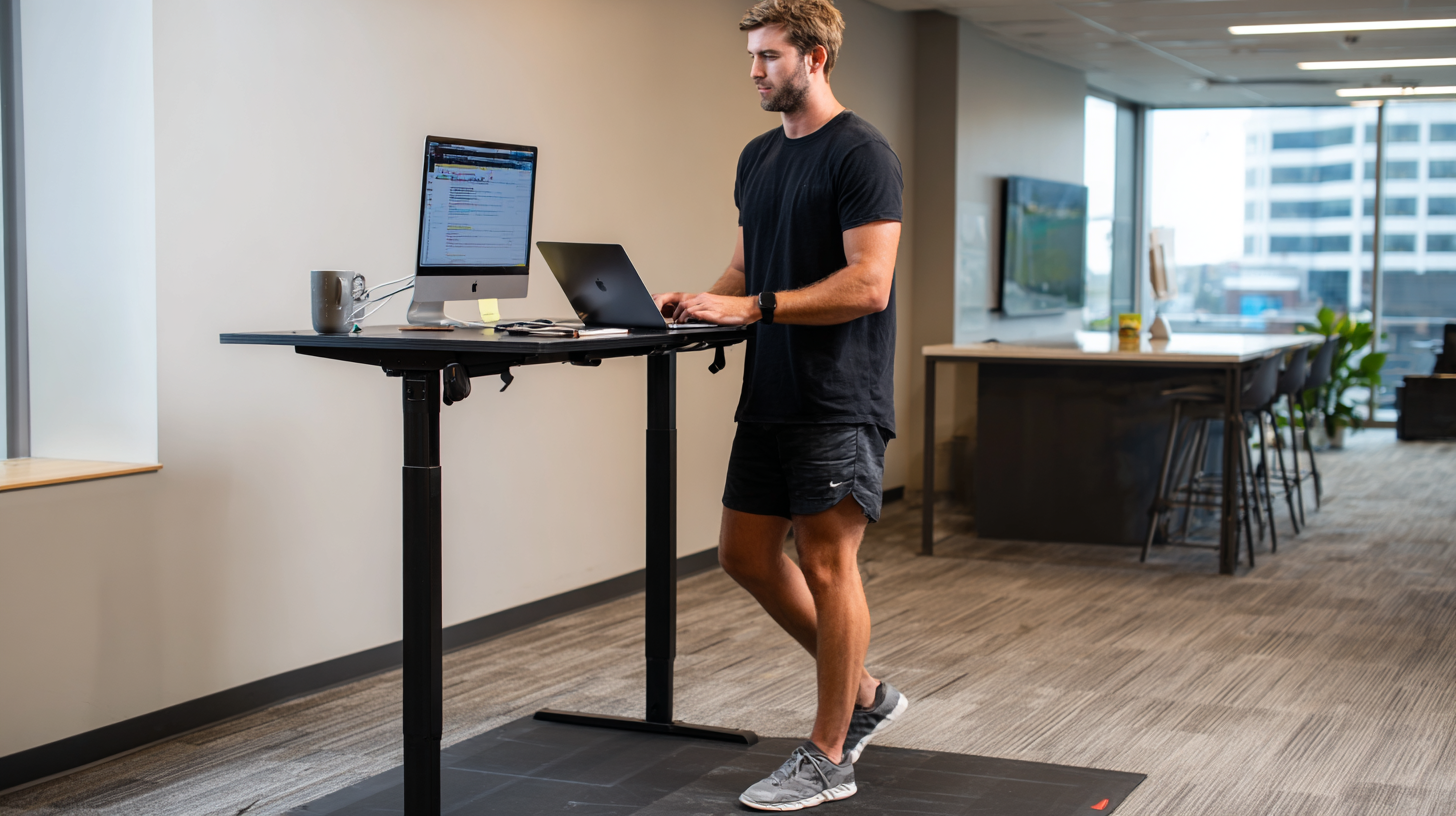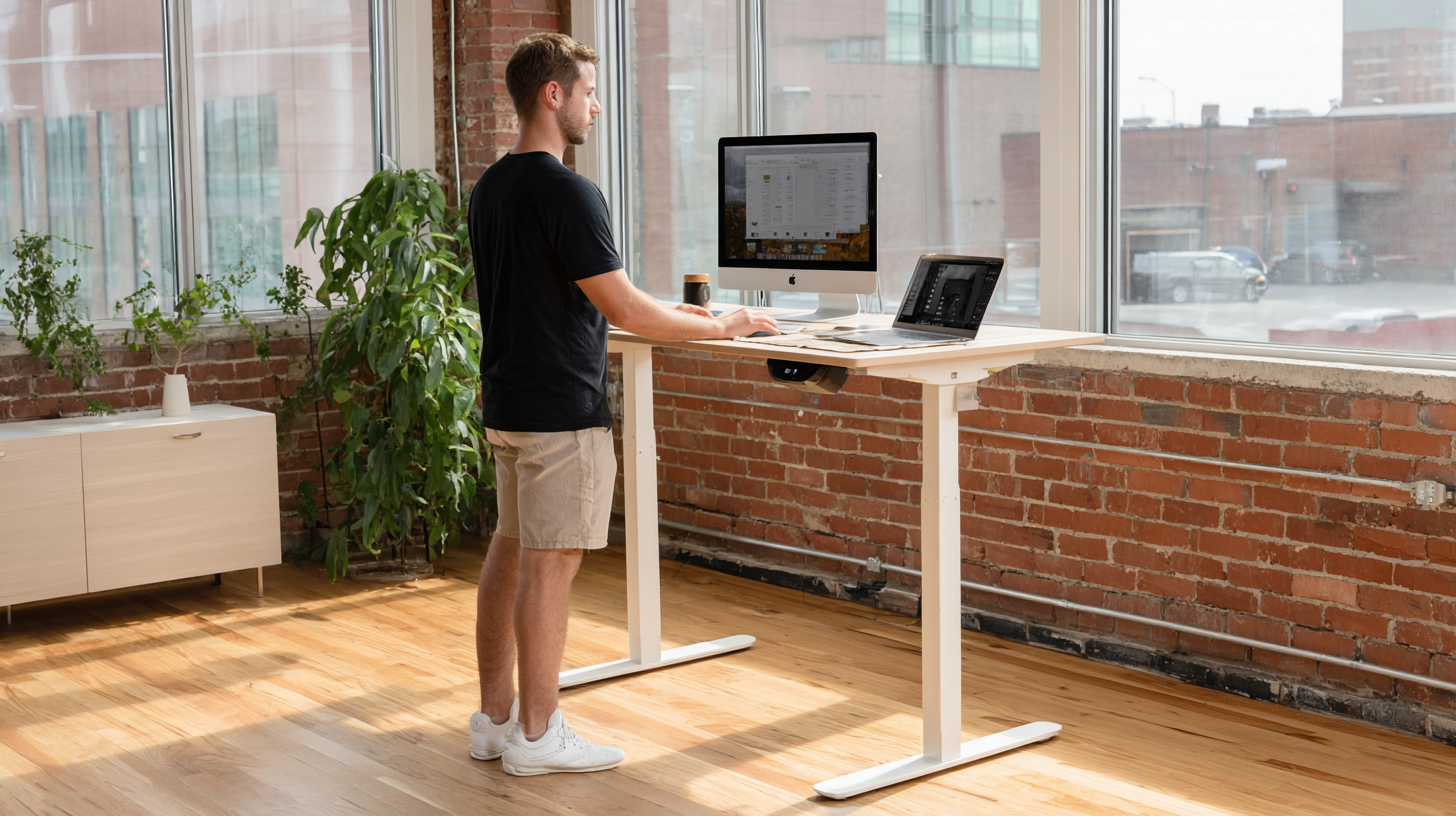As the modern workplace evolves, so does our understanding of health and productivity. One innovative solution gaining traction is the use of a Standing Desk. According to Dr. John Doe, a leading ergonomics expert, "Incorporating a Standing Desk into your daily routine can significantly reduce the risk of chronic diseases associated with prolonged sitting." This highlights the growing importance of creating a healthier work environment, particularly in a time when remote and hybrid work models are more prevalent than ever.

With numerous studies backing the benefits of standing desks—ranging from improved posture and reduced back pain to enhanced energy levels and increased productivity—it's no surprise that many organizations are making the switch. In fact, opting for a Standing Desk can transform not just individual work habits but also the overall workplace culture, fostering a greater focus on health and well-being.
In this article, we will explore the top five benefits of using a Standing Desk, shedding light on how this simple change can lead to significant improvements in both physical and mental health. Embracing a Standing Desk could be a pivotal step towards a more dynamic and health-conscious workplace, paving the way for a brighter, more productive future.
Standing desks have gained popularity as an effective solution for enhancing posture and reducing back pain among office workers. With the rise of sedentary lifestyles, shifting to a standing desk can make a significant difference in how we feel throughout the workday. Standing promotes natural alignment of the spine, which can alleviate strain on the back muscles and decrease the likelihood of developing chronic pain.
To maximize the benefits of a standing desk, it's essential to set it up correctly. Ensure your desk is at elbow height when standing, keeping your wrists straight and hands slightly below elbow level. This positioning not only helps maintain good posture but also minimizes pressure on your wrists and shoulders. Don’t forget to wear supportive footwear, as comfortable shoes contribute to better alignment and can reduce fatigue.
Incorporating movement into your routine is also crucial. Alternate between standing and sitting to avoid fatigue, and consider using a footrest to shift your weight periodically. Simple tips like stretching every hour or using a sit-stand timer can help keep your body engaged and prevent stiffness. With these practices in place, a standing desk can significantly improve both comfort and productivity in your work environment.
 Standing desks have gained popularity in modern workplaces, primarily due to their positive effects on energy levels and focus. Research indicates that using a standing desk can lead to a remarkable increase in energy throughout the workday. A study published in the American Journal of Preventive Medicine highlights that participants who used standing desks reported a 32% improvement in energy levels compared to those seated. By reducing sedentary time, these desks help combat feelings of fatigue that often accompany prolonged sitting.
Standing desks have gained popularity in modern workplaces, primarily due to their positive effects on energy levels and focus. Research indicates that using a standing desk can lead to a remarkable increase in energy throughout the workday. A study published in the American Journal of Preventive Medicine highlights that participants who used standing desks reported a 32% improvement in energy levels compared to those seated. By reducing sedentary time, these desks help combat feelings of fatigue that often accompany prolonged sitting.
Moreover, the impact of standing on focus cannot be underestimated. According to a report by the University of Exeter, workers utilizing standing desks experienced a 12% increase in productivity due to enhanced concentration and mental clarity. The active engagement of the body while standing stimulates blood flow and oxygen circulation, crucial elements for cognitive function. This environment not only boosts individual performance but also fosters a healthier and more dynamic workplace culture, ultimately benefiting both employees and employers alike.
Using a standing desk can significantly enhance your metabolism and aid in weight management, as the risk of liver disease is linked to prolonged sitting. When you stand rather than sit, your body engages more muscles, leading to increased energy expenditure. This not only improves circulation but also enhances your metabolic profile, especially in women, where energy output can differ based on activity levels. Integrating standing desks into your workspace could encourage more movement throughout the day, allowing you to convert nutrients more efficiently into energy, thus supporting overall health.
Moreover, the simple act of standing can have profound effects on your liver function. As your liver plays a crucial role in metabolizing fats, proteins, and carbohydrates, reducing sedentary behavior can lower your risk of developing metabolic disorders. Studies suggest that engaging in even light-intensity activities for as little as 30 minutes a day can create a substantial boost in metabolism. Therefore, adopting a standing desk is not just a trend; it's a scientifically backed strategy to improve your health and maintain a healthy weight while working.
| Benefit | Description | Impact on Metabolism | Impact on Weight Management |
|---|---|---|---|
| Improved Posture | Encourages a natural alignment of the spine. | Promotes better circulation and energy expenditure. | Can help reduce weight gain from prolonged sitting. |
| Increased Energy Levels | Heightened alertness and reduced fatigue. | Supports metabolic function through movement. | May decrease cravings for unhealthy snacks. |
| Reduced Risk of Weight Gain | Minimizes sedentary behavior throughout the day. | Enhances calorie burning compared to sitting. | Promotes healthier weight management strategies. |
| Enhanced Mood | Contributes to a more positive work atmosphere. | Increased physical activity can elevate mood. | Less emotional eating due to improved mental health. |
| Improved Productivity | Facilitates better focus and engagement at work. | Active work encourages sustained energy levels. | Better focus can lead to healthier choices. |
The use of standing desks has been linked to improved mood and mental health, offering significant psychological benefits in the workplace. Research from the American Journal of Preventive Medicine indicates that employees who use standing desks report a 32% improvement in perceived workload and a 29% decrease in feelings of stress compared to those seated all day. This shift not only helps combat the lethargy often associated with prolonged sitting but also fosters a more engaged and motivated work environment.

In addition to reducing stress, standing desks can enhance overall job satisfaction. A study by the University of Sydney found that participants using standing desks experienced a boost in productivity and a 47% increase in engagement over time. The ability to change position throughout the day contributes to a more dynamic work experience, helping to alleviate the monotony of traditional office settings. Moreover, incorporating standing desks can stimulate creativity, as employees tend to think more freely when they are not confined to a seated position. These psychological advantages highlight the importance of a healthier work environment, ultimately leading to better business outcomes and employee well-being.
In today's dynamic work environment, flexibility is key to enhancing productivity and well-being. A
standing desk offers a unique opportunity to adapt your workspace to better suit your needs, allowing for a more comfortable and engaging work experience. By alternating between sitting and standing, you can reduce discomfort and fatigue, which often arise from prolonged sitting. This adaptability not only fosters a healthier physical state but also encourages a more active mindset, promoting creativity and focus.
Tips for maximizing the benefits of a standing desk include adjusting the height so that your elbows remain at a 90-degree angle while typing. This posture significantly reduces strain on your back and neck. Additionally, consider incorporating movement into your routine, such as taking short walks or doing calf raises while standing. This not only keeps your blood flowing but also breaks the monotony of your workday. Remember to invest in an anti-fatigue mat, which can provide extra cushioning and support, enhancing your overall standing experience.
Creating an ergonomic workstation is essential for maintaining productivity. Ensure your screen is at eye level to avoid straining your neck, and keep frequently used items within arm's reach. By tailoring your environment with a standing desk, you maximize comfort and foster a proactive approach to your daily tasks.






